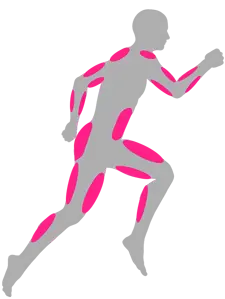Show summary Hide summary
Which muscle group are we activating when bodybuilding or weight training?

Everything you need to know about bodybuilding
What muscles does bodybuilding or weight training work? What parts of the body are engaged and toned in bodybuilding? Use the tool below to see the list of all the body parts that are being used when weight training!
Bodybuilding or weight training for fitness and strength building

What muscles are we exercising when bodybuilding or weight training?
Depending on the sport practised, certain areas of the body will be worked harder than others, but what about when you’re doing bodybuilding? Will you tone and refine your figure by weight training? Below is a list of the muscles and muscle groups that can be strengthened and sculpted by weight training!
Upper limbs (shoulders, arms and forearms)
- Shoulder muscles: These are all the muscles that link the arm to the rest of the body. These include the rotator cuff muscles (subscapularis, infraspinatus, piliatorum, supraspinatus) and the trapezius, deltoid, grand dentle and angular muscles. These muscles provide mobility for the arms and shoulders (rotation, elevation).
- The biceps: These muscles are located on the front of the arm and are surrounded by two joints (scapulohumeral, elbow). The biceps comprise two muscles (long biceps and short biceps) which help flex and rotate the arms.
- The triceps: Located on the inside of the arm, they comprise three muscles (the vastus lateralis, the vastus medialis and the long head of the triceps) which complement the flexor role of the biceps brachii. The triceps allow the forearm to be extended.
Trunk and pelvis (Chest, stomach and back)
- The pectorals: The pectoralis minor and pectoralis major are located in the thorax region and ensure the mobility of the arms and the stability of the shoulder.
- Abdominals: These are made up of several layers of muscle (rectus abdominis, external oblique, internal oblique, transverse), whose function is to flex and rotate the trunk.
- The muscles of the back : The back groups together more muscles such as the trapezius, the dorsalis major, the rhomboids, the infraspinatus and the round muscle. These muscles play a variety of roles. From the dorsal to the lumbar muscles, they ensure the mobility of the arms and shoulder, maintain posture and protect the spine.
Lower limbs (buttocks, thighs and calves)
- Buttocks: Located at the intersection of the lower limbs and the trunk, the gluteal muscles(gluteus maximus, gluteus medius and gluteus minimus) are among the largest and most powerful muscles in the body. In particular, they provide mobility for the thigh and support for the pelvis.
- The quadriceps: These are located at the front of the thigh. The quadriceps are each made up of 4 muscles (the vastus femoris or rectus femoris, the vastus lateralis, the vastus medialis and the vastus intermedius). These muscles facilitate flexion of the thigh on the hip and extension of the leg on the thigh.
- The hamstring muscles: Located on the back of the thigh, there are four of these muscles(biceps femoris, semitendinosus and semimembranosus). They flex the leg and extend the thigh.
- Calf muscles: Also known as the sural triceps, the calf muscles are made up of 3 muscle groups, including the soleus and the gastrocnemius. These muscles help the foot to extend down the leg
If there’s one discipline that allows you to work all the muscles in your body, it’s bodybuilding. Shoulders, pectorals, arms, forearms, back, abs, buttocks, thighs, calves – thanks to the variety of exercises it offers, bodybuilding allows everyone to strengthen and tone their body according to their objectives. With or without equipment, weight training is effective when it is regular and combined with a healthy diet.
Everything you need to know about bodybuilding
What muscles are used in different sports?
All sports in detail!




















































